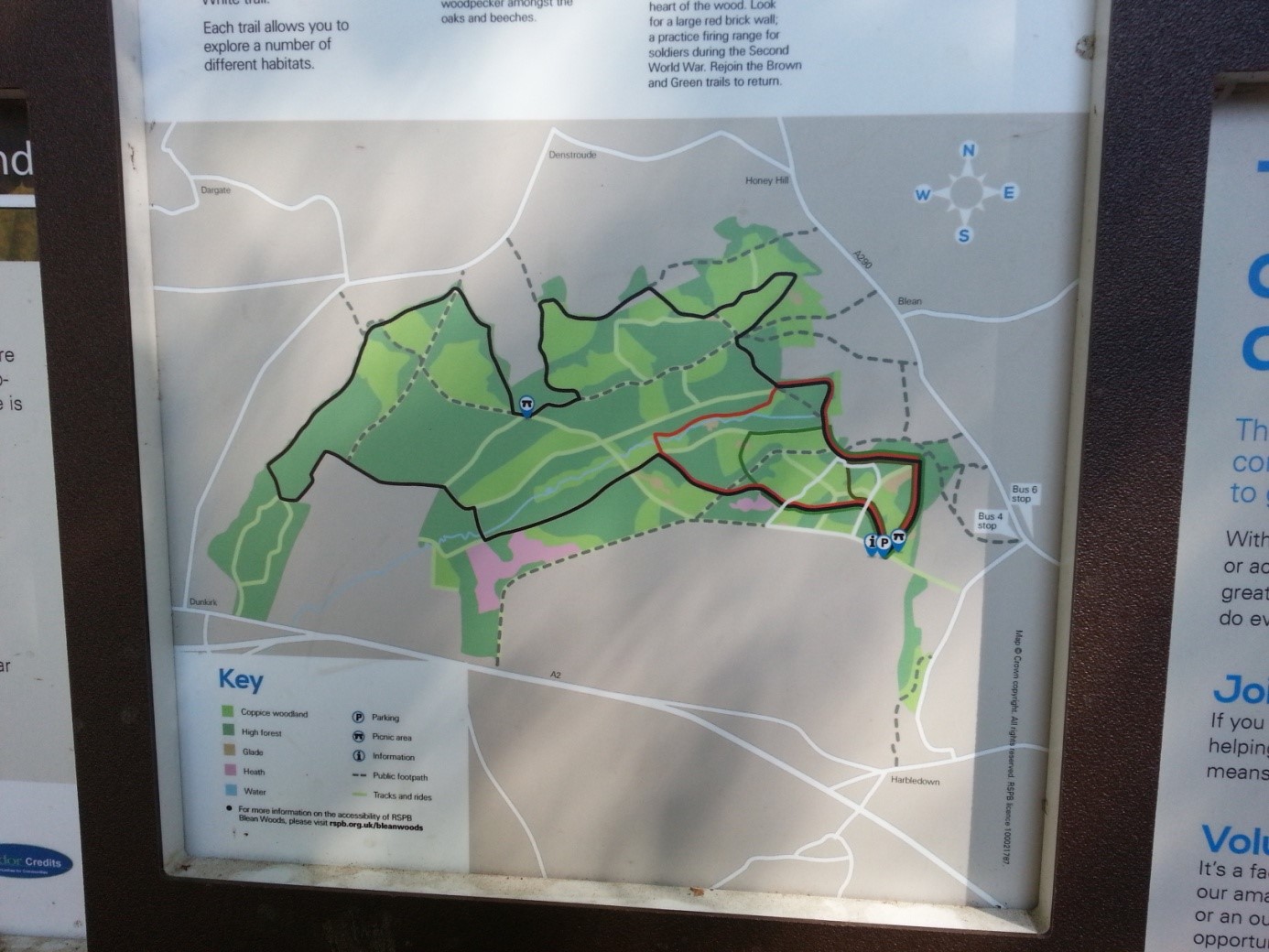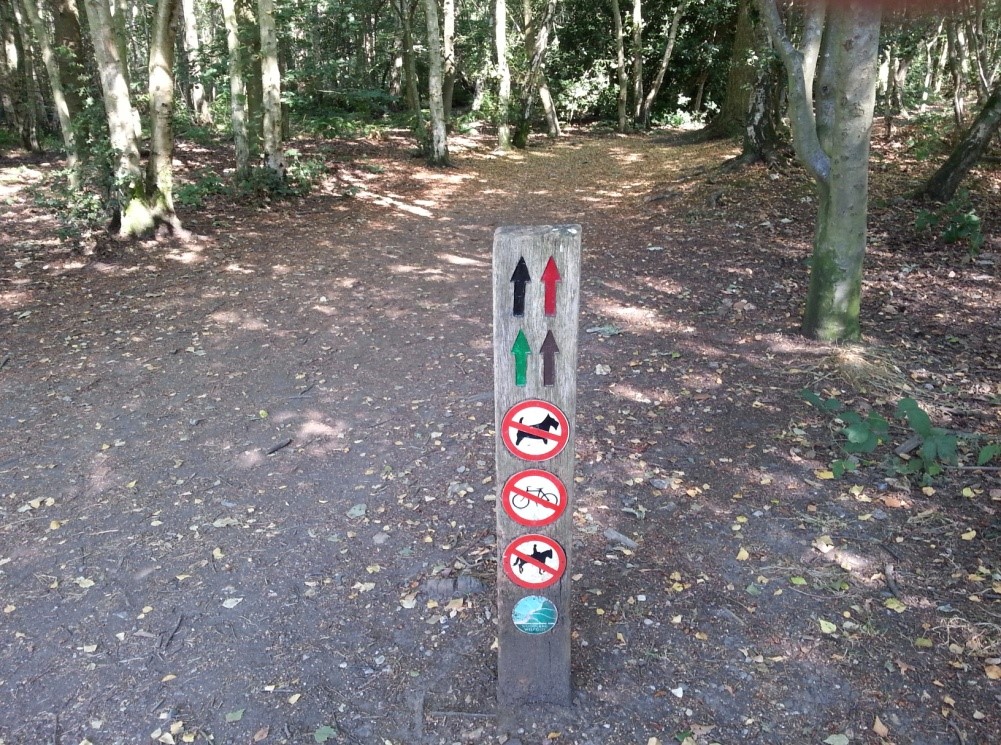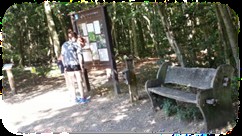- Contents
- Various Articles - Reflections on teaching and education
- Random Teacher’s Thoughts Organized Along A Running Trail
Random Teacher’s Thoughts Organized Along A Running Trail
The Campus of the University of Kent, where most language and teacher training courses, organized and run by Pilgrims, take place, is situated near Blean Woods. There is much to explore and enjoy here – centuries-old trees, lavish vegetation, including quite a few protected species, cool shadows, and picture book-like springs and rivulets.
And then there are the trails. As it is normal for a reservation area, the visitors are expected to keep to the trail, organized in several routes of different length, all equally welcoming, and offering a range of advantages. If you, like me, take to running, this is one of the best areas for it, particularly on a hot summer day. While in Canterbury, I am not the only one to enjoy this experience as often as possible: short, invigorating runs in an early morning of a working day or near ten-mile jogs on a hot Sunday, all on my own or in a large, noisy group.
Running, as you may know, is a thought-encouraging activity. Being a language teacher and teacher trainer on a summer course, a considerable portion of these thoughts naturally concern language teaching. I would like to share these thoughts. You may find parallels between a run and a language class somewhat surprising, but possibly useful.

A: Planning:
You can find all you need to plan your run at the starting point of all trails: a colourful diagram offers sufficient information about the four main routes:
 the shortest brown trail (just under 1 mile)
the shortest brown trail (just under 1 mile)- the moderate green trail (just under 2 miles)
- the longer red trail (about 2.5 miles)
- the longest black trail (about 8 miles)
![]()

You can follow them easily, as there are numerous signs, distributed along the trails and at every junction. Getting lost is impossible. All trails begin and end together.

How would you choose a trail? Normal considerations include, of course, the time you have for running, but also running experience, general fitness, current state, and motivation. An experienced runner may choose a short trail after a “long night”, a less experienced one may decide to a give a long one a try, if they feel it’s a good day or just because “why not”?
How does this relate to teaching?
A class, not only a language class, typically consists of students with different states of “fitness” and “experience” regarding the subject. How often are they given a chance to choose their “trail” in a lesson? What could be achieved, if we defined a clear “starting” and “endpoint” and allow our students to choose their own route: a shortcut, just going through the basics, or a beautiful, long run, giving enough opportunities to indulge in the subtle beauty of a language?

Some may say that opting for an easier choice may, in fact, be discouraging? Is this unavoidable? Let me show you the description of the shortest, easiest trail in the woods: “On our shortest trail, early spring mornings and dusk are accompanied by the beautiful song of the nightingale. Listen for the tapping of great spotted woodpeckers and the elusive lesser spotted woodpecker amongst the oaks and beeches.”
While admitting that this is, indeed, the shortest trail, the text concentrates on what can be gained by choosing it. Are we, as teachers, always aware of the advantages of “easy options”? Do we point them out to our students? Is the conscious choice of one such “easy option” in a classroom less motivating than attempting a task a student cannot cope with?
A beginner may start a run together with an experienced runner, each following their own trail, and they are likely to reach the final line together. Sure, the distance they have covered will be different, but they will both have fulfilled a task. Imagine the poor inexperienced runner being forced onto the red trail, just because “this is the level, generally expected from the class” and giving up half-way. Imagine the frustration of experienced runners, forced to slow down and underperform, so no one will be left behind. How can they make progress corresponding to their abilities?
Giving choices is also vital for managing control in a classroom. Only if students are given control over their own learning, can they be expected to assume responsibility for it.
What if a student makes a wrong choice?
First, we need to define the “wrongness” of a choice. Does it mean opting for too easy a task or for too difficult one? I admit that it can be irritating to put all the effort necessary for creating a range of choices only to find out that students seem to make them by flipping a coin. However, there are real benefits in making the “wrong” choice. Some of them will be discussed as my “run” goes on, but here is the most important one: “wrong” choices will raise your students’ awareness of their own abilities and performance.
Experienced runners may deliberately choose the easiest trail on certain occasions. Maybe they are tired. Maybe it was a long night, or there’re some private issues they need to sort out. Maybe it’s just “one of those days” when they don’t feel like putting too much effort into things. If, however, their choice was based on underestimating their own abilities, they’ll soon find out. They’ll finish the run much earlier than anticipated, will not have even gone out of breath, will be missing the sweat and that special buzz that comes with a good run. In short, their run will be boring and disappointing. If time permits, they’ll probably go for a second round and they’ll most certainly opt for a more demanding trail the next time. A runner, who overestimates his or her abilities will find out even sooner. This may be discouraging, but it is helpful. Under- or overestimating your abilities in a test can be far more discouraging.
Why is self-awareness important?
I believe that we can make reasonable progress, only if we are well aware of our strong and week points and can compare them to our final aims as objectively as possible. If I know, I can only run for 2 miles, before falling apart, but I really want to run a marathon, I also know, I must put some hard work into getting there. Of course, I may also choose to change my aims. In any case, I must be given a chance to train in my own time. Only then can I discover what really works for me. No matter how well-meant and well-informed your training plan for me is, if it feels wrong, if it makes me work too hard at times, when I don’t feel like it and “lets loose”, when I’d love to do some hard training, it’s just useless. Sorry. Finding out what works best for a student will often include some trial and error. We need to offer space and time for that. If I never got bored on that brown trail, I might’ve never risked the green one. If I never realized, how much endurance you need to cover 26.2 miles in less than six hours, I might’ve just trotted down that green path and felt extremely confident, until I tried to run an actual marathon. We cannot pour motivation into our students, just like we cannot pour knowledge. We can, however, offer conditions for them to create their own motivation.
Students’ self-awareness about their actual abilities can be of invaluable help when they sit tests, especially high-stake ones. Testing is not exactly a focus of the humanistic approach, yet few teachers and students are in the luxurious position to skip them altogether. We may tell our students time and again, “Choose the tasks you can do best and do those firsts”, but how will they know what they are really best at if they never had a chance to find out on their own? Worse than trying too much, they could give up, where they could’ve potentially excelled.
Practical implications:
Giving choices sounds good, but creating a range of activities for every lesson can be time-consuming. Here are some “shortcuts” you may try out.
1. The “minimum” principle
Course books often use tasks to promote practice and automatization. These are mostly lists of sentences or shorter expressions that have to be modified, following a certain pattern. Useful as they may be at times, students seldom enjoy these tasks. They can get rather boring, especially those focusing on a grammar phenomenon. How many sentences can you transform from past simple into present perfect before you start yawning? As a humanist teacher, you know, of course, that the learning outcome from such activities can be very poor, but you also know, that your students will need to manage them, in order to pass their finals. Even a better task of this type cannot avoid an element of repetition. I have found the following strategies useful in motivating students and give a choice.
- Set a time limit for the task and a minimum of elements that must be done, for the task to be considered successfully performed. The minimum can be anywhere between 50 and 70% of the whole list. If you have 10 sentences, that have to be transformed in some way, 5 to 7 would mean, task aim achieved.
- Tell your students, they can also choose, which elements to do. They don’t have to begin with 1 and follow on, but can work in any random order.
- Give them time to make their choices before working time begins.
- Encourage students to try out more than the minimum, if they finish earlier, indicating that extra freedom is allowed with extra sentences. Encourage experimentation.
- Be generous with time
What can you get out of this?
Students often plunge into a task, without actually paying attention to what is required. Time to make choices is also time to look into the task more carefully. A typical student will choose those sentences they feel most confident about. These won’t necessarily be the first five, though. Even if it is clearly a teaching stage, some students will worry about errors. To me, however, the real value of this task are those “extra sentences” where students can experiment and take risks in ways, they would otherwise not dare to try.
2. The “students, plan your lesson” principle
Whenever possible, I write a wide choice of topics/tasks/activities on the board before the class begins. It is essential that it should be impossible to cover them all in a certain lesson. On entering the classroom, each student can choose and tick off what they would like do in that particular lesson. They have a total of three ticks and can use them on three different activities, or on only one if they really are interested in it. The “winners” are your lesson plan. After an activity is done, it can be erased, leaving space for a fresh choice for the next class.
You can also have activities or topics “accumulate” ticks in a series of lessons. An easy way to do it is to take a picture of the board at the end of each lesson and copy options with their respective number of accumulated ticks before the next class.
What can you get out of this?
Allowing students to influence the lesson on the level of planning can be a great booster for their motivation and interest. At first, some may just make three ticks without looking or refuse to do it. Others will ask you, what the title of a certain activity means. As the course progresses, and provided you stick to your students’ choices, more and more will get involved in actively shaping “their” lesson.
As a teacher, I can see how my students feel and what takes their interest. I may add extra information, explaining certain tasks to draw attention to them. With some classes, I use a range of symbols from “it’s a laugh” (a smiling balloon) to “deadly” (a skull). The warning seldom discourages students. I will also occasionally change the symbol “easing down” the task. My explanation: as students learn more, a previously “deadly” task becomes easier.
What if only one student is interested in a certain task?
This has actually happened in my class a few times. One student used all her ticks on an activity for seven lessons in a row until it “classified” for the classroom. Such persistence had to be awarded, as the whole class agreed.
What if students consistently fail to select a task, important for their future progress?
If you really need to do something, put it outside the range of choices and explain, why it has to be done.
B: Beginning a Run

Here I am, on the road. A lovely beginning, it always feels so good! The path is clear and wide, there’s enough space for everyone. When I ran with a group, this is the section, where we chat and laugh. As we leave those meters behind us, something more happens though. We can already test if our planning was right. “Did I choose the right trail for myself today? I wanted to do the black one, but am already getting somewhat out of breath, maybe take it easier?” or “Wanted this to be a quick run, but the weather is glorious and I feel really good. Think, I can do that extra mile today.” It can even be, “OK, had set on the read track, but George wants to do the green one, and we are having such a nice chat, think, I’ll go with him.”
How does this relate to teaching?
This is where warm up and revision come in. Planning is all good and important, but reality can always change our plans for us. At the same time, the “easy jog” helps us get into the rhythm of a lesson and focus our attention on the path before us. It goes beyond that, though.
Most course books clearly identify tasks and lessons as “revision” or “learning new stuff”. In our training as teachers, we were asked to produce all those beautiful, detailed lesson plans, where each step needed to be defined as one of these two aspects and rationalized accordingly. You do things in your classroom, either to teach something new, to practice it, or to revise it, conveniently suggesting that it might be acceptable to forget something the first time it is taught, but you must know it after the revision lesson. Here is a question: if our students only learn new things, practice and revise, when can they use language the way it’s meant to be used: speaking, normal, relaxed communication, that doesn’t count how often you use a conditional or a past perfect expression?
This is what an extended warm up or a casual chat is good for. Not “revising”, but “re-chewing” language, using it comfortably to say things we want to say and not things a course book expects us to.
I firmly believe that “warm-ups” are essential for a good lesson, just like they are for a good run. An experienced runner needs a warm-up as much as a beginner. In fact, beginners are more likely to skip it and learn the hard way, that there’s a price to pay for doing so.
What can you get out of this?
Focusing on a run can be easy, but sometimes your thoughts are everywhere, except on the road in front of you. Students don’t always come into the classroom thinking about your lesson and eager to learn. So many things can claim their attention. They may have just had the wort physics test imaginable, they may be recovering from a bad split-up, their mobile phone may have just been stolen ...
As with the first section of a run, some will “plunge” into your lesson easily, others will stumble and pant. They will need time to focus. In any case, they will be better prepared for the next stage.
C: Following Your Trail
There are three important junctions, where trail split. Each one, regardless of length and difficulty, has its advantages and beauty.
C1: The Brown Trail
Being the shortest one, it often is seen as a soft option. It is, however, the best option for people, who have just started running.

The real value of this trail is the moment when you finally manage it, and you are neither out of breath nor tired. You have finally completed with ease, what used to bring you to your limit – a clear sign, that you are making progress. You now have the courage to try another trail next time. The sense of achievement is overwhelming. I have seldom been so motivated to carry on running, as that moment when I finished my short, simple running route for the first time and knew, I could easily do it again.

If running with a “mixed ability group”, following this trail means that I won’t be panting and struggling all the time, and still lagging behind – a rather humiliating experience. Better runners won’t be forced to slow down on my behalf and feel frustrated. I will follow my trail, they will follow theirs, and I can rejoin the group later, for the last stage of the run. At that point I will have covered just about a mile, others – two, three or even eight miles, everyone will be more or less equally exhausted and pleased with their run. More importantly, even though others’ trails were longer, they were different from mine. I have made experiences they haven’t made, seen flowers they haven’t seen, admired century-old trees they haven’t admired. These experiences are equally valuable and worth sharing. I am not “the weakest link”, who slowed everyone down, I didn’t have to give up and I am now part of a group, sharing with everyone that glorious sense of achievement.

I need to make a confession. Even as an experienced runner, I will sometimes take the brown trail, not because I am short of time or tired, but for the luxury of taking the time, of noticing blossoming thistle, beetles shining on the road and silvery cobwebs. I take time to read signs on the side, even to sit in the sun and enjoy the warmth. This may not technically count as a run, but it enhances the pleasure of running.

How does this relate to teaching?
All reasons runners can have, to choose an easy option, are legitimate for students as well. As mentioned before, they may be tired, may feel unwell, preoccupied or may just lack the affinity to English and the aptitude their classmates have. Forcing them through a series of activities that are too challenging, either generally, or at that particular moment, will only confirm the belief, that their work is sub-standard and, in the worst case, that there is no hope for improvement. Giving students the chance to achieve something which, albeit nominally “easier” is still of value is, in my experience, one of the best strategies to build-up motivation.
The so-called “easiest option” can also be an opportunity for stronger students to simply enjoy English, to notice aspects and small elements of beauty they haven’t noticed before and would never notice, if under the constant pressure to produce language as complex as they can produce, as fluently as they can produce it, and in the shortest possible time. Chewing, both of gum and language, may not be particularly demanding, but it certainly can be enjoyable and students, like all humans, like what they can enjoy.
C2: The Green, the Red, and the Black Trail
All arguments for choosing the brown trail are valid for the other three, as well. Sooner or later, a junction will come, where a runner will have to make a final choice: do I follow the shorter trail, or do I carry on, until my only option is a eight-mile run?

Is it really the case? Does this mean that if you overestimated yourself, you are doomed to struggle through a trail beyond your abilities, even if that means you will never put on running shoes again? What if you suddenly remember an appointment and realize, you are running out of time? Well, you still have a chance. A genius, who knew a lot about human nature, created numerous shortcuts. Every few hundred meters, you have a chance to “downgrade” your run to a shorter trail.

Implications for the language classroom
A typical activity following the “minimum principle” as described earlier will give students enough opportunities get a sense of achievement without overstretching themselves, but how about activities, where a choice has to be made beforehand? Such cases can be:
- Choosing a role in a role-play activity
- Choosing a topic for an essay
- Choosing a text for a jigsaw-reading activity
- Choosing a topic for a presentation
- Choosing a text for a review
In all these cases, changing your mind midway may prove impossible. Worse: in some cases, like jigsaw-reading, a student’s failure to understand and explain/retell their part of the text may fail the whole group. We need to offer students shortcuts – opportunities to “downgrade” their trail and still finish the run. Here is a procedure I use successfully, offering shortcuts at various stages (adapted from “Ask me about”, an activity I learned from Chris Price):
- After a reasonably long warm-up/priming stage, students choose a text or part of text related to a topic. In a CLIL lesson, these could be, for example, the properties of certain metals or information about different continents/countries/regions. In a business lesson, the texts could be about different types of companies. In a general English lesson, you may have descriptions of characters form a book or story students have read/are expected to read. Based on class dynamics, you may specify a level of difficulty for each text in advance or correlate text length with difficulty.
- Having made their choices, students are given adequate time to work with the text on their own. The time will depend on text length and the type of reading you expect for completing the task. Obviously, if you only want your students to skim or scan, they’ll have less time than for intensive reading. In any case, lower level students (A1 – A2), may need up to 6 times the time you need, intermediate students (B1-B2) – up to 4 times, advanced students (C1-C2) – about twice the time.
- Students are now grouped with others, who have made the same choice and can compare their understanding of the text. This is a great opportunity for cooperative learning and a chance for those, who find the text too challenging, to still cope with the task (First shortcut). As a teacher, you have a few options at this stage.
- You may monitor and provide help where necessary.
- You may invite students to seek your help, when needed. The main rule here: one student from a group can approach you with a question, which you answer as straightforward as possible. They go back to their group and provide the answer.
Both strategies have obvious advantages and disadvantages. In the first case, you make sure everyone “gets it right” but run the risk to “help out” where no help is really needed, and students would’ve solved a problem on their own, hadn’t you interfered. In the second case, you only help where it’s absolutely necessary. Students have to be aware of a problem and how to ask for help before they send a messenger to you. On the other hand, they may all misunderstand a text. I tend to monitor with lower level students and with new groups, where students may not yet have developed enough confidence and trust to come and directly ask for help. With all other groups, I prefer to leave students negotiate solutions and only ask for help, when no one in a group can come up with one. For me as a teacher, this provides valuable information for language areas I need to focus upon in subsequent lessons.
- Back on their seats, students write their headline on the one side of a clean piece of paper (e.g. “mercury”, “potassium”, “chlorine”; “Germany, “India”, “Mexico”; “Elizabeth”, “Lydia”, “Mr Darcy” etc). On the back, they write words and expressions that will help them share information with their peers. They may use their notes and dictionaries or ask for help. (Second shortcut)
- Back in their groups, students compare their “helpful phrases” and explain why they find them important for fulfilling the task successfully. They can also copy useful words from other students. (Third shortcut).
- Students now share information. Based on numbers and class dynamics, you can:
- Ask students mingle. They show each other their headlines and share information. The notes on the back can be much needed help or simply reassuring. If possible, plan for enough time so everyone can talk to more than one student about the same topic. This will take the pressure to really tell everything important, off less confident students, will ensure that students get all the relevant information in the end, and will provide an opportunity for some useful repetition.
- Students work in groups and share information. For this setup, you have to ensure that roughly the same number of students will choose a text so you can create groups. Having two students with the same text in a group can only work, if they are equally confident speakers and share the text, otherwise, the stronger student is likely to take over.
- Now, that all students have all the information, they can concentrate on the final stage of the task. This can be done individually (e.g. completing a table with the properties of each chemical element, writing an essay etc.) or cooperatively (e.g. a presentation on the groups’ ideas about the characters’ lives after the end of “Pride and Prejudice”)
This procedure may seem time-consuming, but the language output is usually rather high and students have the opportunity to perform to the best of their abilities.
D: Rejoining the Group and Finishing Your Run Together

The trails reunite in the opposite order of their “split-offs”: the red joins the black one, the green joins the two, and the brown completes the set. When running with a group, each reunion is a moment of joy. People are excited and willing to share impressions and memories. Having “outrun” the green trail years ago, I am still surprised by details I have overlooked or forgotten, but others have noticed and are excited about. In return, I can tell them about the beauty of my favourite trail and draw attention to some lovely spots they may want to pay attention to when they decide to venture it. Despite all the choices available and all the shortcuts, it can happen that someone is still slower than the rest of the group and we have to wait for them. This is never a problem. The junctions, where the trails reunite are particularly beautiful and at every such junction, you will find a bench. Those, who are already tired have a chance to rest for a while before the final, the others have enough to explore: information signs, narrow paths into the woods, birds, butterflies or rare plants to look for ... Of course, some may decide to run on but there are always enough runners willing to wait for the slow ones or even run back their trail and offer help, if necessary.

Once the group is complete, we can finish the run together. We get back where we started, a bit sweatier, a bit more tired, but also bit fitter and often a bit happier. We have done it. For some, it may be a routine run, for others – a first, but the sense of achievement is universal.
Once again, the fastest have the chance to sit for a while and have a breather or compare their run with the map and possibly make plans for their next one. Are they going to take the same trail? Are they now confident enough to try a longer one?

How does this relate to teaching?
Unless you work only in one-to-one settings, you probably know the constant struggle to balance off your response to the learning needs of individual students and those of the whole class. I feel that finishing a lesson as a group, no matter how much individual work it entailed, is important for creating a sense of group achievement. As a runner on my own, I can do a routine and go back home. It is an enjoyable experience, but very different from the run in a group, where people can share impressions and feelings. There is a difference between “I did it” and “we did it” that shouldn’t be underestimated. This is even more valuable, as some students actually “went back” to help others achieve their aim.
Implications for the language classroom
There are numerous possibilities to reunite a class at the end of an activity or a lesson. Surely, you have your favourites. Here are some of mine:
- Help your peers: stronger students often tend to sit next to each other. Unless you do some regrouping, this means, that they are likely to finish an activity faster than others, even if they have made the most demanding choices. If rapport and class dynamics permit it, I encourage these students to join other groups and offer help. It is important, however, that they follow one important: they may not “take over” and do all the work for their peers.
- Recap. This can be done as a discussion, with questions flowing from teacher to students or students to teacher, or as a short recap-presentation. As a teacher, you probably use a recap to focus on particularly important elements from a lesson, most often on content (meaning).
- Feedback. It often concentrates on form rather than content.
- Publishing. Whenever students produce written texts – individually or as a group, I feel it is important to “publish” them. The easiest way to do it would be to distribute them around the classroom and let students read their peers texts. Of course, you will need a clear set of rules regarding errors. Do students have a chance to correct and rewrite a text before publishing? Are they instructed to ignore errors? May they give each other feedback and help with text correction? Would that apply to the whole class or is feedback limited to groups? This may be a useful strategy, if there are tensions in the class and some students tend to over-criticize others or feel too shy to give any feedback.
- Presentations. Where groups were expected to prepare presentations, this is a natural end of a lesson. Again, you will need a clear set of rules for time limits, students’ participation (Does everyone in the group have to “perform” or is it acceptable that one student presents the work of the entire group?), questions from you and from students (Are interruptions allowed? What is the time limit for asking questions?), and feedback (In what form? When? After each presentation? At the end?)
- Expectations discussion. Students compare their expectations at the beginning of the lesson with the actual outcome, point elements of interest and elements that were less interesting/useful/efficient in their view. In a large class, you may choose to have the discussion running in groups first, and then compare groups’ views or you can accept that not everyone will have a say at the end of every lesson. As a teacher, you will know, if what a student says is accepted by a majority or if it is an “odd view” not shared by the rest in any case.
E: Say “Goodbye”
I am now at the end of my run. My students are leaving the room. Some are tired, some are happy. I don’t know which trail they are going to try next time. Did the shy ones gather enough confidence to try something “riskier”? You know they can manage, but have they finally realized it themselves? Have the over-confident ones got a more realistic idea of the amount of training they actually need in order to improve their performance? Even if not, there will be another opportunity. As long as you encourage them to keep going, as long as you help them see the importance of persistence, they’ll get there. As for now, it’s time to have a break.
Please check the Pilgrims courses at Pilgrims website.
Please check the English Course for Teachers and School Staff at Pilgrims website.
Please check the How to be a Teacher Trainer course at Pilgrims website
Purpose Beyond Profit: It’s One Thing to “Do Good”, Another to “Stop Doing Bad”…
Adrian Underhill, UKThe Reunion. On Intuitive Observation in Educational Situations
Henk van Oort, the NetherlandsRandom Teacher’s Thoughts Organized Along A Running Trail
Marina Marinova, Germany